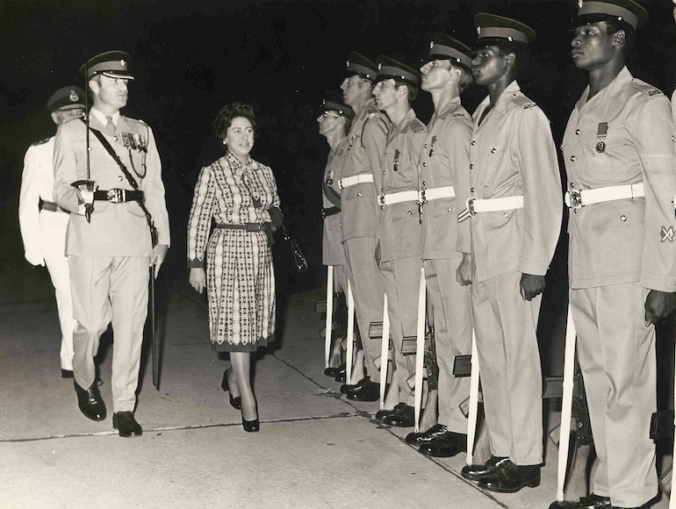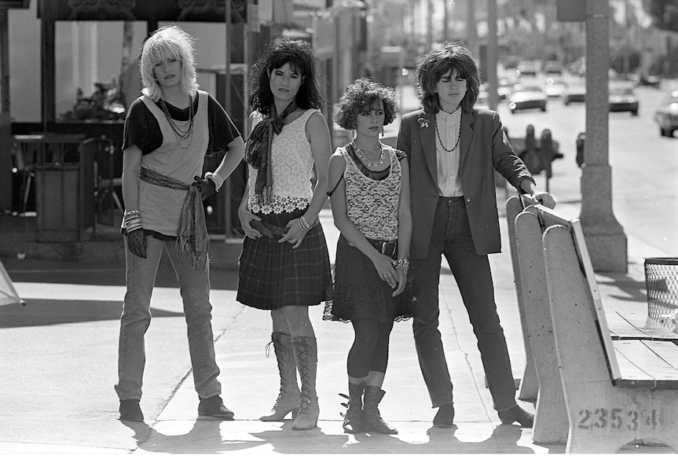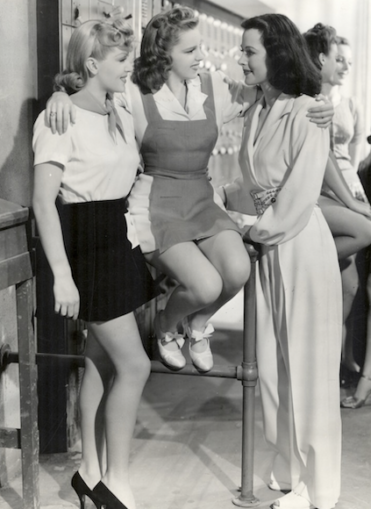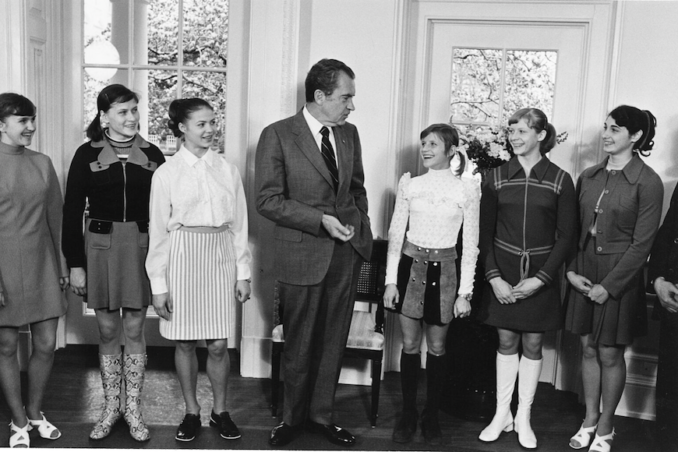We play a game at work with girls’ heights. There is a reason for this. Colleagues are going to build a tunnel to the shop next door and steal their toys. To confuse the local constabulary, we’re also going to knock a till over to make it look like a robbery. We need to know how tall our young ladies are for the dimensions of the tunnel. Also to decide who’s tasked to crawl back with what to our bargain outlet’s wardroom which, handily, has a land border with Discount Toy Canyon.
Thus far, we have a couple of four-foot tens and too many to mention five-foot exactlies. We are not a tall race. Our sections are only six shelves high. In our environment, natural selection fine-tunes female intelligence as far as the use of the stool. Any higher is a man’s job.
With some fairer sex co-workers, such a division of labour marks me down as a dinosaur. These days there are no men’s and women’s jobs, rather those for tall persons and those for not-so-tall persons. Likewise when lifting heavy weights. If a girl can’t do it, it becomes a two-person job, not a man’s – at least in the nomenclature, if not the actualité.
Which set me thinking about little women. To glam things up, are there any celebs or famous faces of a certain stature passing through the busy motorway junction next to our car park who might stop off, invest in a few bargains and lend a hand with the digging?
Princess Margaret
Princess Margaret, the younger sister of Queen Elizabeth II, was known for her elegance, strong personality, distinctive style and for being only 5’1′. Her older sister at 5’4′ was not a giant but is disqualified from our tunnel building because of trouble with her eyes – they’re too far from the ground.
I don’t like to disappoint, but Puffins hoping for yet another rehash of all those stories about Cilla Black on aeroplanes need to realise the Scottie Road screamer was 5′ 6 1/2′ and is also disqualified, as is 5’5′ Mrs Thatcher.
Despite her short height, those in the know recall Princess Margaret as having a commanding presence that often made her appear taller than she was. Her shortage of inches never overshadowed her influence or the attention she commanded in public and private life.

RAF Akrotiri, Cyprus. HRH The Princess Margaret,,
Brian Harrington Spier – Licence CC BY-SA 2.0
Renowned for her striking beauty and fashion sense, Princess Margaret made an indelible mark on the British Royal Family and society at large. She was a trendsetter, often seen wearing the latest couture and setting fasions that many followed both at home and around the globe. Her larger-than-life persona made her one of the most memorable figures in modern British royal history, but try telling that to her grandmother.
According to the Princess’s biographer, Craig Brown, Queen Mary teased Margaret from her earliest childhood. ‘Ach, you tiny little tsing, I can hardly see you’, the German nobleman’s daughter would say. In what the supermarket trade would call a girl fight, but what royal biographers label as ‘undying enmity’, the little tsing nicknamed her grandmother (real name Queen Victoria Mary Augusta Louise Olga Pauline Claudine Agnes of Teck) as ‘May’.
Princess Margaret’s set would sneer at May’s ‘morganatic hands’ which were a sign to the aristocracy-aware that her marriage to King George V was a ‘left-handed’ union between unequal social ranks. Now, now, girls, best of order!
In terms of inheriting the right set of non-morganatic genes, Margaret and her set will have been relieved that Queen Mary was 5’7′ whereas Margaret’s royal ancestor proper, Queen Victoria, was a reassuring 4’11’. While we’re on the issue, old flame Group Captain Townsend was a quarter of an inch shy of being a six-footer. Spouse Lord Snowdon, a survivor of teenage polio, was 5’5′.
Craig comments,
‘Even the most glamorous years, her twenties, of Princess Margaret’s film-star beauty, were marred by this lack of height; consistently remarked upon, initially with sympathy but later with cruel accuracy. It is no surprise that she was to develop a self-protective shell of aloofness.
‘It may be a cliché that smaller people are by nature aggressive, but it is only natural to find some way of holding one’s own. In millionaires and movie stars, it may be mildly amusing; in paupers, it was deemed merely mockable (‘Who does that little man think he is?’). In princesses, it comes over as hoity-toity.’
Which begs the question, is Small Woman Syndrome a thing?
Small Woman Syndrome
Might such a term describe a set of behaviours sometimes exhibited by shorter women who feel the need to be more forceful in social or professional situations? While not a formal psychological diagnosis, the concept has a parallel in what is called the “Napoleon Complex,” a term applied to shorter men who display aggressive or domineering behaviour to compensate for their lack of height.
The notion behind Small Woman Syndrome is that shorter women may feel underestimated or overlooked due to their height, prompting them to adopt more assertive, confident and confrontational attitudes to ensure they are not dismissed or ignored.
This can manifest in various ways, such as speaking loudly, taking charge in group settings, or being too determined in competitive environments. These behaviours can be seen as a defence mechanism against societal tendencies to associate height with authority or competence. Not always a bad thing, might it give a small lady an advantage in show business or sport?
Susanna Hoff
Shorter than Princess Margaret, Puffins’ favourite American singer, songwriter and actress (and a founding member of The Bangles) Susanna Hoff is 5′ 1/2′. If you’re five feet tall and a Californian, you count the halves. Being petite might be an attractive look in show business, but only if they can see you. One of Susanna’s agent’s responsibilities is to push her to the front in Bangles photos. Even allowing her to stand in line is fraught as she looks odd rather than cute.

The Bangles, posing on street in Los Angeles,
Aurelio Jose Barrera, Los Angeles Times – Licence CC BY-SA 4.0
Before Puffins get over-excited, Susanna is battling the calendar as well as the tape measure. Seven when Bobby Moore lifted the World Cup, in her eleventh year as Neil Armstrong stepped onto the Moon, Susanna arrived into a world where Eisenhower was president and Fidel Castro was about to capture Havana. Jo Biden was still a teenager.
Yes, Ms Hoff is sixty-five but doesn’t look it. Is her lack of ageing in the genes? No, it’s plastic surgery. What about her height? Could be. When pictured with her mother, Tamar Ruth Simon Hoff (a youthful 89-year-old former writer, painter and filmmaker) the pair of them look the same height and, thanks to a bit more tuck, nip and filler, about the same age.
On the other side of the family, Sussana’s father passed only a few weeks ago, aged 91. Joshua Hoffs M.D. was born in New York City to parents Saul and Dorothy. A high school classmate of Ruth Bader Ginsburg, at Harvard he studied psychoanalysis alongside Sigmund Freud’s daughter Anna. In 1957, he qualified in medicine at Yale and moved to California with his young wife Tamar. Mr and Mrs Hoff were married for 67 years.
Judy Garland
Elsewhere in show business, the shorter woman’s yellow brick road to success can be fraught. Actress, singer and dancer Judy Garland was 4’11’ and struggled with her weight and the extreme measures needed to maintain a Holywood image. From a young age, Garland experienced intense pressure from the studios, particularly Metro-Goldwyn-Mayer, where she signed as a young girl in the 1930s. Studio executives obsessed with her appearance, deeming her weight a problem despite her natural petite frame.

Lana Turner, Judy Garland, and Hedy Lamarr in Ziegfeld Girl,
Metro-Goldwyn-Mayer (MGM) – Public domain
Garland was put on strict diets and was often given appetite suppressants, including amphetamines, to control her weight. This harsh regime started when she was still a teenager, around the time she starred in “The Wizard of Oz” (1939), a role that cemented her fame but also exposed her to the harsh realities of the entertainment industry. She was often deprived of food, given only a limited amount of chicken soup, black coffee and other low-calorie foods. The pressure to maintain a slim figure was relentless, and the constant monitoring of her diet by studio handlers caused both physical and emotional damage.
This forced starvation and the use of stimulants led to long-term health issues for Garland. The combination of restrictive eating, diet pills, and the gruelling work schedule imposed by the studio contributed to her lifelong battle with addiction and poor mental health. Garland’s struggles with her weight and the extreme measures she took were part of a broader pattern of exploitation by Hollywood studios during that era, where young actresses were often forced to conform to unrealistic standards of beauty.
These pressures took a severe toll on Garland’s well-being, leading to a cycle of addiction that plagued her throughout her life. Her tragic experiences highlight the dark side of Hollywood’s golden age, where the pursuit of perfection often came at an unbearable cost. Garland died in London in 1969, aged only 47. A coroner’s court recorded her death as due to an incautious self-overdose of barbiturates.
Surely young ladies are treated better these days?
Simone Biles
Simone Biles, the American gymnastics superstar, stands at 4′ 8′ tall. Her petite stature plays a significant role in her success as a gymnast, giving her an advantage in performing the complex and powerful moves that have become her trademark. Biles’ height, combined with her exceptional strength, agility, and technical skill, allows her to execute difficult routines with remarkable precision and control.
The 27-year-old dominates the sport of gymnastics and is one of the most decorated gymnasts in history. Her height, which might be considered a disadvantage in many sports, has instead become an asset. Gymnastics, particularly women’s artistic gymnastics, perceives shorter stature as advantageous, leading to the belief the sport may restrict or influence the height of female athletes. This perception is rooted in several factors that have made shorter gymnasts more successful.

Travis Kelce, Simone Biles, and Dr. Oz,
Erik Drost – Licence CC BY-SA 2.0
Shorter athletes tend to have a lower centre of gravity, which can enhance balance, stability and control during complex routines. This physical attribute is beneficial for executing the intricate and powerful manoeuvres required, such as flips, twists, and vaults. Shorter limbs allow for faster rotation, which is crucial for performing multiple aerial moves in quick succession.
This places a question mark beside training regimes, which begin at a very young age and involve intense physical conditioning that can sometimes impact natural growth patterns. Concerns and studies suggest rigorous training schedules, combined with strict dietary controls often imposed on young gymnasts to maintain a certain physique, might contribute to delayed growth or shorter final adult height.
Intense physical activity, along with restricted caloric intake, can affect the release of growth hormones, leading to stunted growth. Furthermore, the sport’s culture favours smaller, lighter bodies, influencing the selection of gymnasts who fit this ideal. Coaches and scouts may be more likely to select and invest in athletes who are shorter, perpetuating the cycle.
In counter-argument, while these factors may influence height, they do not wholly determine it. Genetics plays a significant role in a person’s height, and not all gymnasts experience restricted growth. The trend towards shorter gymnasts is a complex interplay of physical advantages, training intensity, and cultural preferences within the sport.
In terms of genes, Simone’s younger sister, Adria, is six inches the taller, which points us towards the fitness, training and diet regime that the young gymnast is subjected to. Because of race, sex, sex abuse – and because the money keeps rolling in – the media only hints at 4’8′ Simone’s situation. A previous less pecuniary generation of female gymnasts is more forthcoming.
Olga Korbut

Nixon Standing in the Oval Office with the Soviet Women’s Gymnastics Team,
Nixon White House Photographs – Public domain
From her present-day home in Scottsdale, Arizona, Olga Korbut (4’11’) opens up about the abuse she suffered. The 61-year-old Bellosrsussia-born mother-of-one who won gold for the USSR at the 1972 Munich Olympics, emigrated to the United States 1991. Since then she has coached gymnastics, been convicted of shoplifting from a Publix convenience store and has told of her own experiences of intense competition training.
Olga refers to her former coach Renald Kynsh as a sex abuser, loner, despot and weirdo – allegations he denies. She recalls a training regime that included being forced to take drugs to stop her body from developing and having to smoke to stay thin. Ms Korbut had to note down everything she ate and even count how many sips of water she took.
The intense schedule began at age ten when she enrolled in a sports school. Sometimes training for 20 hours a day, her periods didn’t start until she was twenty. Numerous injuries resulted in a metal rod being inserted into an arm and at one point she went around with a weight attached to a limb to straighten it. She also had to practice her smile in front of a mirror until she cried.
Chastened by the plight of little women, the plan changes. We shall head in the opposite direction, away from Discount Toy Canyon to the sunlit, wooded uplands of the Premier Lodge. The tall gentlemen shall stand below the windows. The shorter ladies upon their shoulders will roll over the sills and steal the illegal immigrants’ freebies. A confused local constabulary will blame a far-right Russian bot resident in Pakistan *taps nose*.
© Always Worth Saying 2024



